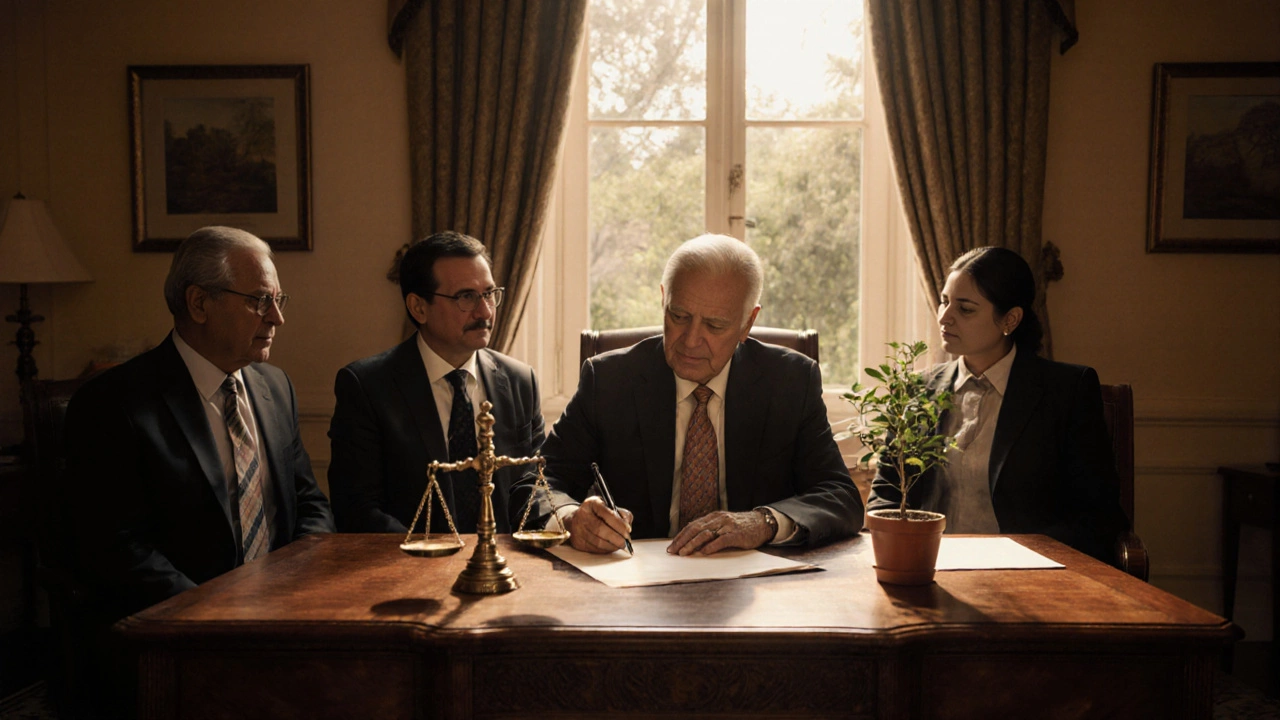Want to set up a charitable trust in New Zealand? Here’s what you need: legal requirements, setup steps, trustee duties, and tips for real-world success.

- Created by: Lydia Carmichael
- Completed on: 15 Oct 2025
- Categories: Charities
Charitable Purpose Validator
Validate Your Charitable Purpose
Check if your proposed charitable purpose meets legal requirements for tax-exempt status. Input your purpose statement and get immediate feedback.
The law requires that charitable purposes fall into one of four recognized categories. Vague purposes can lead to regulatory challenges and loss of tax-exempt status.
Purpose Validation Results
Enter your purpose and click "Validate Purpose" to see if it meets legal requirements.
Quick Takeaways
- A charitable trust is a legal arrangement that holds assets for a defined public benefit.
- Its core purpose must fall into one of the recognized charitable purpose categories, such as relieving poverty or advancing education.
- Trustees manage the trust, while the settlor defines its mission in the trust deed.
- Charitable trusts enjoy tax exemptions and can provide donors with tax deductions.
- Compliance with the Charities Act (or relevant tax code) is essential to keep the trust’s status.
What Is a Charitable Trust?
In plain terms, a charitable trust is a legal vehicle where a settlor transfers assets to trustees who must use them only for charitable objectives defined in a governing document. The trust does not operate for profit; any income generated is reinvested to further its mission.
Unlike a charity incorporated as a company, a trust has no shareholders. It exists solely because the settlor’s intention, captured in the trust deed is a written instrument that outlines the trust’s purpose, assets, and operation rules, directs the trustees, and names the beneficiaries - typically the public or a specific community group.
Core Charitable Purposes Under the Law
Most jurisdictions limit charitable activity to four broad purpose categories. A trust that strays outside these areas risks losing its tax‑exempt status.
| Purpose Category | Typical Activities |
|---|---|
| Relief of Poverty | Food banks, shelter programs, emergency grants |
| Advancement of Education | Scholarships, school funding, literacy programs |
| Promotion of Religion | Church maintenance, faith‑based outreach, religious education |
| Other Community Benefits | Environmental conservation, arts support, health research |
When drafting the trust deed, the settlor must clearly articulate which of these purposes the trust will pursue. Ambiguity can lead to regulatory challenges.
How a Trust Fulfills Its Purpose
The trust’s success hinges on three key roles:
- Settlor: The person who creates the trust and decides its charitable mission. The settlor’s intent is the legal backbone that courts use to interpret the trust’s actions.
- Trustee: The individual or board responsible for managing assets, investing prudently, and ensuring that distributions align with the stated purpose. Trustees owe a fiduciary duty to act in the best interest of the public benefit.
- Beneficiary: In a charitable context, beneficiaries are the members of the public who receive the trust’s benefits, not private individuals. The trust must demonstrate that its programs reach the intended beneficiaries.
Each role is defined in the trust deed and reinforced by statutory duties. For example, trustees must keep accurate records, file annual returns, and avoid conflicts of interest.

Tax and Financial Advantages
One of the biggest draws of setting up a charitable trust is the tax relief it offers. In the United States, the IRS grants 501(c)(3) status, which means:
- Income generated by the trust is exempt from federal income tax.
- Donors can claim a charitable deduction on their personal returns, subject to limits.
- Capital gains on donated assets are not taxed at the time of transfer.
In the United Kingdom, the equivalent is a charitable exemption from corporation tax and eligibility for Gift Aid, which adds 25% to eligible donations at no extra cost to the donor.
These benefits only apply if the trust maintains its tax exemption status by complying with the relevant charitable legislation and filing annual reports. Failure to do so can lead to revocation of the exemption and penalties.
Governance and Compliance
Good governance keeps the trust on the right side of law and public trust. Key compliance checkpoints include:
- Charities Act (or IRS Code): The primary legislation that defines what qualifies as a charity, the reporting requirements, and the powers of the regulator.
- Annual Reporting: Submission of financial statements, activity reports, and a narrative of how the charitable purpose was pursued.
- Audit Requirements: Depending on size, a trust may need an independent audit to verify that funds were used correctly.
- Beneficiary Impact Assessment: Evidence that the trust’s programs actually benefit the intended group, often required during regulator reviews.
Maintaining a clear governance structure-typically a board of trustees that meets regularly, records minutes, and monitors performance-helps avoid the common pitfalls of mismanagement.
Common Pitfalls to Avoid
Even well‑meaning trusts can stumble. Here are the most frequent mistakes:
- Vague Purpose: A trust deed that says “help people” without specifying the charitable category invites regulator scrutiny.
- Conflict of Interest: Trustees who benefit personally from trust transactions breach fiduciary duties.
- Poor Record‑Keeping: Incomplete books make audits difficult and can trigger investigations.
- Inadequate Funding: Relying solely on one donor means the trust may not survive if that donor withdraws.
Addressing these issues early-by drafting a precise deed, implementing conflict‑of‑interest policies, and setting up a robust accounting system-saves time and money later.

Starting Your Own Charitable Trust: A Step‑by‑Step Guide
- Define the Charitable Purpose: Choose one of the recognized categories and write a concise mission statement.
- Draft the Trust Deed: Work with a solicitor experienced in nonprofit law to create a deed that names the settlor, trustees, purpose, and asset handling rules.
- Appoint Trustees: Select individuals with relevant expertise-finance, law, the sector you’ll serve-and obtain their written consent.
- Transfer Assets: Move cash, property, or investments into the trust’s name. For large assets, obtain a valuation.
- Register with the Regulator: In the US, file Form 1023 with the IRS; in the UK, apply to the Charity Commission. Provide the deed, trustee details, and a projected budget.
- Set Up Accounting: Choose an accounting software that can handle fund accounting and generate the required reports.
- Launch Programs: Begin activities that directly address the charitable purpose, documenting outcomes from day one.
- Maintain Ongoing Compliance: File annual returns, hold trustee meetings, and conduct impact assessments each year.
Following these steps helps ensure the trust is legally sound, financially transparent, and mission‑driven from the start.
Frequently Asked Questions
Can a family set up a charitable trust for their own benefit?
No. The law requires that the benefits be for the public or a defined charitable class, not for private family members. Attempts to do otherwise can lead to loss of tax‑exempt status.
How long does it take to get charitable‑trust status?
In the US, the IRS review can take 2‑6months after a complete Form1023 submission. In the UK, the Charity Commission typically responds within 12weeks.
Do trustees receive a salary?
They can, but only if the trust’s governing documents allow it and the compensation is reasonable, documented, and approved by the board.
What happens if a trustee breaches their duties?
The trustee can be removed by the other trustees or the regulator, and they may be liable for any loss caused by the breach.
Is a charitable trust required to have an official address?
Yes. Regulators need a registered address for correspondence and public transparency.
Next Steps for Aspiring Trustees
If you’re considering starting or joining a charitable trust, begin by reviewing the Charities Act or the relevant tax‑code to understand eligibility criteria. Then, talk to a solicitor who specializes in nonprofit law to draft a solid trust deed. Finally, gather a committed board, secure initial funding, and file the registration paperwork.
With a clear purpose, diligent governance, and proper compliance, a charitable trust can turn assets into lasting community impact.
Discover the ins and outs of charitable trusts, exploring the benefits and downsides of setting one up. Learn how they can offer tax advantages and ensure long-term support for causes you care about, while also understanding potential pitfalls like administrative complexities. Perfect for anyone considering philanthropy through a structured tool, this article provides a balanced view on how charitable trusts work.
Learn what a charitable trust is, its legal purpose, tax benefits, governance rules, and how to set one up for lasting community impact.

